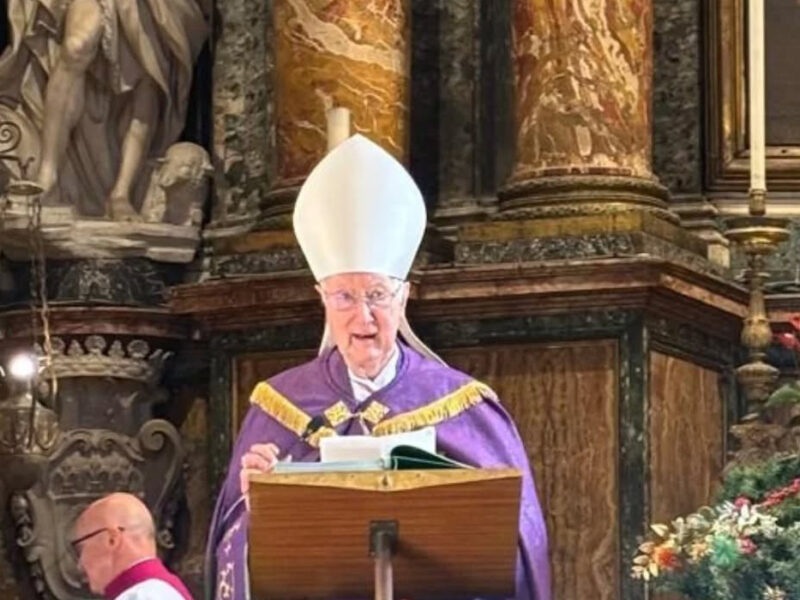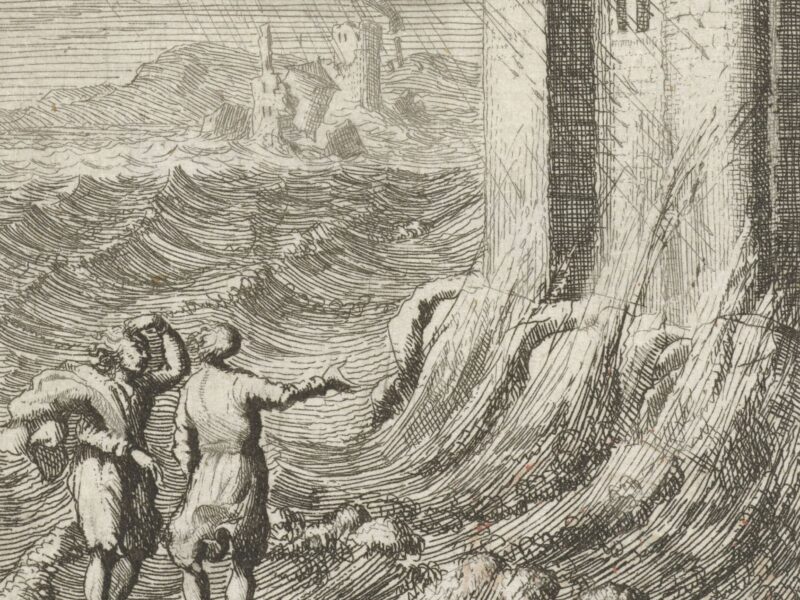
Disciples in the Dark, Part II
As we celebrate the beginning of the Apostolic Age, Br Augustine ponders the Pentecostal resonance of the Church’s Sacraments.

At the Last Supper, the Lord promised his Apostles the Spirit, who ‘will remind you of all that I have said to you’ (Jn 14:26). God has given his Holy Spirit to the Church, and the Spirit is our memory of the divine mysteries he has enacted on earth. My memory allows me to see myself as having a past I can make present to myself, the tapestry sewn from threads of experience. The Spirit recalls and makes Christ manifest to the Church, uniting her to Christ’s life and mission: this life of the Spirit in the Church takes tangible form in the sacramental life. The Spirit leads us, by the Church’s Sacraments, to respond to the love manifested in Christ’s life. For this reason, the Catechism of the Catholic Church calls the Spirit the ‘artisan of God’s masterpieces, the sacraments of the New Covenant. The desire and work of the Spirit in the heart of the Church is that we may live from the life of the risen Christ’ (1091-1092). It is fitting, then, that our celebration of the coming of the Spirit is at the end of Eastertide, for it is by the life of the Spirit in the Church that we are led to the eternal Easter.

These seven flowers painted on wax represent the seven Sacraments. The vine represents Christ, the True Vine (Jn 15:1), and the Sacraments, represented by the flowers, are ‘powers that come forth from the Body of Christ. The Holy Spirit is like the sap of the Father’s vine which bears fruit on its branches’ (Catechism 1116, 1108). Here, the natural proclaims the supernatural: the candle is ‘the work of bees’ and ‘of human hands’ (Exsultet) gathering from the bountiful earth, and it gives back to her Creator by bearing aloft its flame, the smoke of prayers piercing the heavens. It stands in the sanctuary of the church, just as Christ has entered beyond the veil of the heavenly sanctuary, making perpetual intercession for us. It stands in our midst, just as Christ stood in the midst of the Apostles in the upper room, reminding us not to be a church closed in on itself, but a Church willing to pour itself out ‘for the life of the world’ (Jn 6:33).
The floral pattern represents the visible creation, which ‘speaks of God and symbolises both his greatness and his nearness’ (Catechism 1147). In the God who has taken human flesh, and risen from the tomb, we behold that our ‘earth has bud forth a Saviour’ (Is 45:8). It is positioned directly under the Cross and the pierced side of Christ, for it was from this cleft that came forth ‘the wondrous sacrament of the whole Church’ (Sacrosanctum Concilium 5.2). And in the Church, Christ manifests the fruits of his love’s redeeming work through the Sacraments. The Scriptures illustrate this with the imagery of water: the water flowing from below the Temple threshold grows into a great river teeming with creatures and sustaining trees that provide nourishment, ‘and everything will live where the river goes’ (Ezek 47:9,1,12). So does the Lord ‘fill the earth with his love’ (Ps 33:5) by the living water from his wounded side.
The three black-and-white flowers represent the three Sacraments of Christian Initiation, i.e. Baptism, Confirmation and the Eucharist. The stark contrast of black-and-white evokes our radical need to die to sin and live anew in Christ, a need fulfilled by these sacraments.
The two violet flowers represent the two Sacraments of Healing, i.e. Penance and the Anointing of the Sick. The violet is for the ongoing work of the reconciliation and restoration of all in Christ, a work often painful to participate in: we approach these sacraments when we have come face-to-face with human finitude. Yet we have the assurance of Christ that ‘sorrow will turn into joy’ (Jn 16:20): in the Church’s liturgical colour-scheme, violet always leads to gold, as Advent precedes the cheer of Christmas and Lent the light of Easter.
The two white lilies with yellow filaments represent the sacraments directed toward the salvation of others, i.e. Holy Orders and Matrimony. For this reason, the filaments reach outward: these sacraments serve to build up the people of God by reflecting, in a special way, his fruitful love. Those ordained are consecrated in Christ’s Name ‘to feed the Church by the word and grace of God’ (Lumen Gentium 11.2), and those married are to share in the common work of watching over creation: ‘Be fruitful and multiply, and fill the earth and subdue it’ (Gen 1:28).

Since the Spirit makes present in the Sacraments the power of Christ, the Sacraments are our encounter with Christ. The scene pictured here is evocative of the encounter between Christ and the Apostle Thomas in the upper room, where Thomas acknowledges Christ, ‘My Lord and my God’ (Jn 20:28). Here, Thomas is portrayed by St Thomas Aquinas, who in the moving words of his poem Te devote laudo refers to this Easter episode in evoking the Church’s Eucharistic faith:
‘I am not like Thomas, wounds I cannot see,
but I plainly call thee Lord and God as he:
Let me to a deeper faith daily nearer move;
daily make me harder hope and dearer love.’
Thomas, whose seventh centenary of canonisation we celebrate this year, is an example of a saint who bore such witness by sharing the fruits of his theological contemplation. He is here depicted holding a chalice receiving the Blood of Christ: as a contemporary Orthodox theologian remarks, theology is to be imbibed from the Eucharistic chalice. In animating the Church, the Spirit becomes the language by which the Sacraments are conveyed, made present, yet the very language of ‘sacrament’ – an outward sign of inward grace – suggests that to live in the Spirit is to be caught up in the interplay of divine elusiveness and divine encounter. This interplay is made manifest in the Eucharistic mystery, in which the reality signified is present by a different mode of being: we receive the fulness of Christ hidden under the forms of bread and wine, and not his physical body which walked on earth. Yet the effect of the Sacrament resonates with the purpose of his Incarnation: through his Body and Blood, he draws us into union of love with him, and so leads us to the fulness of life (Jn 6:51-58, 10:10) through the daily living of our Christian lives.
This bond of love is the Holy Spirit. For us, this means the joy of the Eucharist belongs to Pentecost as it does to Pascha: the Eucharist is the perfect institutional expression of the Church’s exultant certitude of her life, risen and triumphant in the Lord Christ, who at the Last Supper prayed that we may all be one, as he and the Father are one in the bond of the Spirit. The Spirit gives expression to our longing for our Lord, a desire deeper than words (Rom 8:26), for he ‘comes upon the bread and wine and accomplishes what surpasses every word and thought’, and the offerings become the Body and Blood of Christ (St John Damascene). Pentecost is the birthday of the Church, and so the reality of Pentecost is re-presented at every Mass, when the Spirit’s action supplies us with the source and summit of our Christian life, the Eucharist (Catechism 1324). The Spirit re-capitulates our unity in Christ, our Head, by drawing us into this mystery of our faith, one so ancient and so new.
And what a mystery it is. The Christ we receive is the same beheld by the Apostles, yet the Eucharistic encounter is always radically new: it places in the past all our existing knowledge of God. This is not to say that our knowledge of what God is about is superseded or supplanted by the sublimity of the encounter; rather, our knowing is made new: what we can know about God passes into the past, since he cannot be circumscribed by our cognition. Thomas’ treatment of theology is suffused with unknowing, with his submission before the sublimity of that which surpasses all thought. Our knowledge of God grows with our knowledge of what he is not, a knowledge consonant with faith and charged with hope that we may ‘see him as he is’ (1 Jn 3:2). Disciples in the dark, may we be ‘led by the Spirit’ into his Temple, along the way of the Cross and Resurrection (Lk 2:27, Ps 43:3). May ‘our hearts be pure from evil that we may see aright’ (St John Damascene), and live in the light given us, the light that crowned the Apostles at Pentecost. And may Christ God, who has promised us his Spirit for us to remember him here, remember us all in his Kingdom. Amen.


